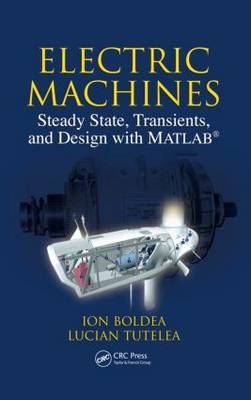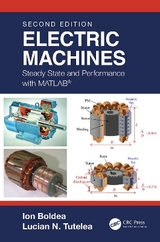
Electric Machines
Crc Press Inc (Verlag)
978-1-4200-5572-6 (ISBN)
- Titel erscheint in neuer Auflage
- Artikel merken
Ubiquitous in daily life, electric motors/generators are used in a wide variety of applications, from home appliances to internal combustion engines to hybrid electric cars. They produce electric energy in all electric power plants as generators and motion control that is necessary in all industries to increase productivity, save energy, and reduce pollution.
With its comprehensive coverage of the state of the art, Electric Machines: Steady State, Transients, and Design with MATLAB® addresses the modeling, design, testing, and manufacture of electric machines to generate electricity, or in constant or variable-speed motors for motion control.Organized into three stand-alone sections—Steady State, Transients, and FEM Analysis and Optimal Design—the text provides complete treatment of electric machines. It also:
Explores international units
Contains solved and proposed numerical examples throughout
Guides students from simple to more complex math models
Offers a wealth of problems with hints
The book contains numerous computer simulation programs in MATLAB and Simulink®, available on an accompanyingdownloadable resources, to help readers make a quantitative assessment of various parameters and performance indices of electric machines. Skillfully unifying symbols throughout the book, the authors present a great deal of invaluable practical laboratory work that has been classroom-tested in progressively modified forms. This textbook presents expressions of parameters, modeling, and characteristics that are directly and readily applicable for industrial R&D in fields associated with electric machines industry for modern (distributed) power systems and industrial motion control via power electronics.
Professor Ion Boldea, University Politehnica, Timisoara, Romania, is an IEEE Fellow and has worked, published, lectured and consulted extensively on linear and rotary electric motors and generators: theory, design and control. He has published 13 books in USA and UK throughout the last 30 years. Assoc. Prof. Lucian Tutelea, University Politehnica, Timisoara, Romania, is an IEEE member and also has taught, worked, published papers, lectured and consulted for numerous international companies in the field of electric machines and drives.
Part I: Steady State
Introduction
Electric Energy and Electric Machines
Basic Types of Transformers and Electric Machines
Losses and Efficiency
Physical Limitations and Ratings
Nameplate Ratings
Methods of Analysis
State of the Art and Perspective
Electric Transformers
AC Coil with Magnetic Core and Transformer Principles
Magnetic Materials in EMs and Their Losses
Electric Conductors and Their Skin Effects
Components of Single- and 3-Phase Transformers
Flux Linkages and Inductances of Single-Phase Transformers
Circuit Equations of Single-Phase Transformers With Core Losses
Steady State and Equivalent Circuit
No-Load Steady State (I2 = 0)/Lab2.1
Steady-State Short-Circuit Mode/Lab2.2
Single-Phase Transformers: Steady-State Operation on Load/Lab 2.3
Three-Phase Transformers: Phase Connections
Particulars of 3-PhaseTransformersonNoLoad
General Equations of 3-Phase Transformers
Unbalanced Load Steady State in 3-Phase Transformers/Lab2.5
Paralleling3-PhaseTransformers
Transients in Transformers
Instrument Transformers
Autotransformers
Transformers and Inductances for Power Electronics
Preliminary Transformer Design (Sizing) by Example
Energy Conversion and Types of Electric Machines
Energy Conversion in Electric Machines
Electromagnetic Torque
Passive Rotor Electric Machines
Active Rotor Electric Machines
Fix Magnetic Field (Brush-Commutator) Electric Machines
Traveling Field Electric Machines
Types of Linear Electric Machines
Brush-Commutator Machines: Steady State
Introduction
Brush-Commutator Armature Windings
Brush-Commutator
Airgap Flux Density of Stator Excitation MMF
No-Load Magnetization Curve by Example
PM Airgap Flux Density and Armature Reaction by Example
Commutation Process
EMF
Equivalent Circuit and Excitation Connection
DC Brush Motor/Generator with Separate (or PM) Excitation/Lab4.1
DC Brush PM Motor Steady-State and Speed Control Methods/Lab4.2
DC Brush Series Motor/Lab4.3
AC Brush Series Universal Motor
Testing Brush-Commutator Machines/Lab 4.4
Preliminary Design of a DC Brush PM Automotive Motor by Example
Induction Machines: Steady State
Introduction: Applications and Topologies
Construction Elements
AC Distributed Windings
Induction Machine Inductances
Rotor Cage Reduction to the Stator
Wound Rotor Reduction to the Stator
Three-Phase Induction Machine Circuit Equations
Symmetric Steady State of 3-Phase IMs
Ideal No-Load Operation/Lab 5
Zero Speed Operation (S=1)/Lab5.2
No-Load Motor Operation (Free Shaft)/Lab 5.3
Motor Operation on Load (1 > S > 0)/Lab5.4
Generating at Power Grid (n > f1/p1, S < 0)/Lab5.5
Autonomous Generator Mode (S < 0)/Lab5.6
Electromagnetic Torque and Motor Characteristics
Deep-Bar and Dual-Cage Rotors
Parasitic (Space Harmonics)Torques
Starting Methods
Speed Control Methods
Unbalanced Supply Voltages
One Stator Phase Open by Example
One Rotor Phase Open
Capacitor Split-Phase Induction Motors
Linear Induction Motors
Regenerative and Virtual Load Testing of IMs/Lab 5.7
Preliminary Electromagnetic IM Design by Example
Synchronous Machines: Steady State
Introduction: Applications and Topologies
Stator (Armature) Windings for SMs
SM Rotors: Airgap Flux Density Distribution and EMF
Two-Reaction Principle via Generator Mode
Armature Reaction and Magnetization Reactances, Xdm and Xqm
Symmetric Steady-State Equations and Phasor Diagram
Autonomous Synchronous Generators
Synchronous Generators at Power Grid/Lab 6.4
Basic Static- and Dynamic-Stability Concepts
Unbalanced Load Steady State of SGs/Lab6.5
Large Synchronous Motors
PM Synchronous Motors: Steady State
Load Torque Pulsations Handling by Synchronous Motors/Generators
Asynchronous Starting of SMs and Their Self-Synchronization to Power Grid
Single-Phase and Split-Phase Capacitor PM Synchronous Motors
Preliminary Design Methodology of a 3-Phase PMSM by Example
Part II: Transients
Advanced Models for Electric Machines
Introduction
Orthogonal (dq) Physical Model
Pulsational and Motion-Induced Voltages in dq Models
dq Model of DC Brush PM Motor (ωb =0)
Basic dq Model of Synchronous Machines (ωb =ωr)
Basic dq Model of Induction Machines (ωb = 0,ωr,ω1)
Magnetic Saturation in dq Models
Frequency(Skin) Effect Considerationin dq Models
Equivalence between dq Models and AC Machines
Space Phasor (Complex Variable) Model
High-Frequency Models for Electric Machines
Transients of Brush-Commutator DC Machines
Introduction
Orthogonal (dq) Model of DC Brush Machines with Separate Excitation
Electromagnetic (Fast) Transients
Electromechanical Transients
Basic Closed-Loop Control of DC Brush PM Motor
DC–DC Converter-Fed DC Brush PM Motor
Parameters from Test Data/Lab8.1
Synchronous Machine Transients
Introduction
Phase Inductances of SMs
Phase Coordinate Model
dq0 Model—Relationships of 3-Phase SM Parameters
Structural Diagram of the SM dq0 Model
pu dq0 Model of SMs
Balanced Steady State via the dq0 Model
Laplace Parameters for Electromagnetic Transients
Electromagnetic Transients at Constant Speed
Sudden 3-Phase Short Circuit from a Generator at No Load/Lab9.1
Asynchronous Running of SMs at a Given Speed
Reduced-Order dq0 Models for Electromechanical Transients
Small-Deviation Electromechanical Transients (in PU)
Large-Deviation Electromechanical Transients
Transients for Controlled Flux and Sinusoidal Current SMs
Transients for Controlled Flux and Rectangular Current SMs
Switched Reluctance Machine Modeling for Transients
Split-Phase Cage Rotor SMs
Standstill Testing for SM Parameters/Lab9.3
Linear Synchronous Motor Transients
Transients of Induction Machines
Three-Phase Variable Model
dq (Space Phasor) Model of IMs
Three-Phase IM–dq Model Relationships
Magnetic Saturation and Skin Effects in the dq Model
Space Phasor Model Steady State: Cage and Wound Rotor IMs
Electromagnetic Transients
Three-Phase Sudden Short Circuit/Lab 10.1
Small-Deviation Electromechanical Transients
Large-Deviation Electromechanical Transients/Lab 10.2
Reduced-Order dq Model in Multimachine Transients
m/Nr Actual Winding Modeling of IMs with Cage Faults
Transients for Controlled Magnetic Flux and Variable Frequency
Cage Rotor Constant Stator Flux Transients and Vector Control Basics
Doubly Fed IM as a Brushless Exciter for SMs
Parameter Estimation in Standstill Tests/Lab10.3
Split-Phase Capacitor IM Transients/Lab10.4
Linear Induction Motor Transients
Part III: FEM Analysis and Optimal Design
Essentials of Finite Element Method in Electromagnetics
Vectorial Fields
Electromagnetic Fields
Visualization of Fields
Boundary Conditions
Finite Element Method
2DFEM
Analysis with FEM
FEM in Electric Machines: Electromagnetic Analysis
Single-Phase Linear PM Motors
Rotary PMSMs (6/4)
The 3-Phase Induction Machines
Optimal Design of Electric Machines: The Basics
Electric Machine Design Problem
Optimization Methods
Optimum Current Control
Modified Hooke-Jeeves Optimization Algorithm
Electric Machine Design Using Genetic Algorithms
Optimization Design of Surface PMSMs
Design Theme
Electric and Magnetic Loadings
Choosing a Few Dimensioning Factors
A Few Technological Constraints
Choosing Magnetic Materials
Dimensioning Methodology
Optimal Design with Genetic Algorithms
Optimal Design of PMSMs Using Hooke-Jeeves Method
Optimization Design of Induction Machines
Realistic Analytical Model for Induction Machine Design
Induction Motor Optimal Design Using Genetic Algorithms
Induction Motor Optimal Design Using Hooke-Jeeves Algorithm
Machine Performance
| Erscheint lt. Verlag | 24.11.2009 |
|---|---|
| Zusatzinfo | 1154+ equations - PPI 606; 20 Tables, black and white; 444 Illustrations, black and white |
| Verlagsort | Bosa Roca |
| Sprache | englisch |
| Maße | 156 x 234 mm |
| Gewicht | 1293 g |
| Themenwelt | Technik ► Elektrotechnik / Energietechnik |
| ISBN-10 | 1-4200-5572-0 / 1420055720 |
| ISBN-13 | 978-1-4200-5572-6 / 9781420055726 |
| Zustand | Neuware |
| Informationen gemäß Produktsicherheitsverordnung (GPSR) | |
| Haben Sie eine Frage zum Produkt? |
aus dem Bereich



